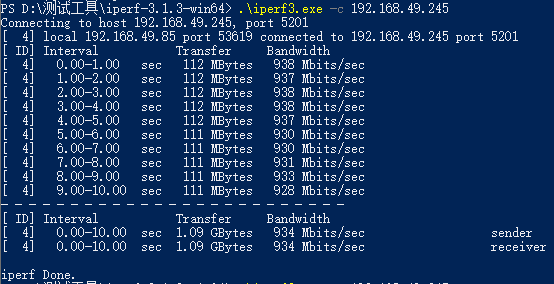Ethernet
The development board is equipped with 2 Gigabit network ports
- ETH0 RGMII: end0, default network card.
- ETH1 RGMII: end1.
- Please use an Ethernet cable to connect the corresponding network port of the development board and the PC to the same router.
Network connectivity test
Enter the file system and execute the following command to obtain the IP and view the network port configuration information.
root@linaro-alip:/# ifconfig
end0: flags=4163<UP,BROADCAST,RUNNING,MULTICAST> mtu 1500
inet 192.168.49.176 netmask 255.255.255.0 broadcast 192.168.49.255
inet6 fe80::561a:9e84:b5bd:20d7 prefixlen 64 scopeid 0x20<link>
ether 32:b0:e6:11:eb:7e txqueuelen 1000 (Ethernet)
RX packets 3236 bytes 236287 (230.7 KiB)
RX errors 0 dropped 569 overruns 0 frame 0
TX packets 745 bytes 63449 (61.9 KiB)
TX errors 0 dropped 0 overruns 0 carrier 0 collisions 0
device interrupt 69
end1: flags=4099<UP,BROADCAST,MULTICAST> mtu 1500
ether 36:b0:e6:11:eb:7e txqueuelen 1000 (Ethernet)
RX packets 0 bytes 0 (0.0 B)
RX errors 0 dropped 0 overruns 0 frame 0
TX packets 0 bytes 0 (0.0 B)
TX errors 0 dropped 0 overruns 0 carrier 0 collisions 0
device interrupt 67Execute the following command to test whether the network port is connected to the external network normally, taking "www.baidu.com" as an example. "-I" represents the specified network port, and without "-I", the default network card is used. You can press "Ctrl + C" to terminate the ping command.
root@linaro-alip:/# ping www.baidu.com -I end0
PING www.a.shifen.com (183.2.172.42) 56(84) bytes of data.
64 bytes from 183.2.172.42 (183.2.172.42): icmp_seq=1 ttl=50 time=9.28 ms
64 bytes from 183.2.172.42 (183.2.172.42): icmp_seq=2 ttl=50 time=8.77 ms
64 bytes from 183.2.172.42 (183.2.172.42): icmp_seq=3 ttl=50 time=8.65 ms
64 bytes from 183.2.172.42 (183.2.172.42): icmp_seq=4 ttl=50 time=8.83 ms
64 bytes from 183.2.172.42 (183.2.172.42): icmp_seq=5 ttl=50 time=8.63 ms
64 bytes from 183.2.172.42 (183.2.172.42): icmp_seq=6 ttl=50 time=8.73 ms
--- www.a.shifen.com ping statistics ---
6 packets transmitted, 6 received, 0% packet loss, time 5007ms
rtt min/avg/max/mdev = 8.630/8.813/9.275/0.216 ms
root@linaro-alip:/# ping www.baidu.com -I end1
PING www.a.shifen.com (183.2.172.42) 56(84) bytes of data.
64 bytes from 183.2.172.42 (183.2.172.42): icmp_seq=1 ttl=50 time=8.35 ms
64 bytes from 183.2.172.42 (183.2.172.42): icmp_seq=2 ttl=50 time=8.88 ms
64 bytes from 183.2.172.42 (183.2.172.42): icmp_seq=3 ttl=50 time=9.07 ms
64 bytes from 183.2.172.42 (183.2.172.42): icmp_seq=4 ttl=50 time=8.91 ms
64 bytes from 183.2.172.42 (183.2.172.42): icmp_seq=5 ttl=50 time=8.67 ms
64 bytes from 183.2.172.42 (183.2.172.42): icmp_seq=6 ttl=50 time=8.66 ms
64 bytes from 183.2.172.42 (183.2.172.42): icmp_seq=7 ttl=50 time=8.78 ms
64 bytes from 183.2.172.42 (183.2.172.42): icmp_seq=8 ttl=50 time=8.41 ms
--- www.a.shifen.com ping statistics ---
8 packets transmitted, 8 received, 0% packet loss, time 7011ms
rtt min/avg/max/mdev = 8.352/8.716/9.068/0.230 msTCP Bandwidth Test
Server
Install the iperf3 tool on the development board and run the following command:
root@linaro-alip:/# sudo apt update
root@linaro-alip:/# sudo apt install iperf3The development board acts as the server and executes the following commands:
root@linaro-alip:/# iperf3 -s
-----------------------------------------------------------
Server listening on 5201 (test #1)
-----------------------------------------------------------Client
The iperf3 tool for Windows can be obtained in the test tool kit.
Open PowerShell in the Windows system, enter the path where the iperf3 tool is located, and use Windows as the client to send data. Execute the following command:
.\iperf3.exe -c 192.168.137.149 // 192.168.137.149为服务端IP地址Test Results
- Server
root@linaro-alip:/# iperf3 -s
-----------------------------------------------------------
Server listening on 5201 (test #1)
-----------------------------------------------------------
Accepted connection from 192.168.49.85, port 53618
[ 5] local 192.168.49.245 port 5201 connected to 192.168.49.85 port 53619
[ ID] Interval Transfer Bitrate
[ 5] 0.00-1.00 sec 112 MBytes 936 Mbits/sec
[ 5] 1.00-2.00 sec 112 MBytes 937 Mbits/sec
[ 5] 2.00-3.00 sec 112 MBytes 939 Mbits/sec
[ 5] 3.00-4.00 sec 112 MBytes 938 Mbits/sec
[ 5] 4.00-5.00 sec 112 MBytes 937 Mbits/sec
[ 5] 5.00-6.00 sec 111 MBytes 931 Mbits/sec
[ 5] 6.00-7.00 sec 111 MBytes 929 Mbits/sec
[ 5] 7.00-8.00 sec 111 MBytes 930 Mbits/sec
[ 5] 8.00-9.00 sec 111 MBytes 933 Mbits/sec
[ 5] 9.00-10.00 sec 111 MBytes 929 Mbits/sec
[ 5] 10.00-10.00 sec 265 KBytes 885 Mbits/sec
- - - - - - - - - - - - - - - - - - - - - - - - -
[ ID] Interval Transfer Bitrate
[ 5] 0.00-10.00 sec 1.09 GBytes 934 Mbits/sec receiver
------------------------------------------------------------ Client

